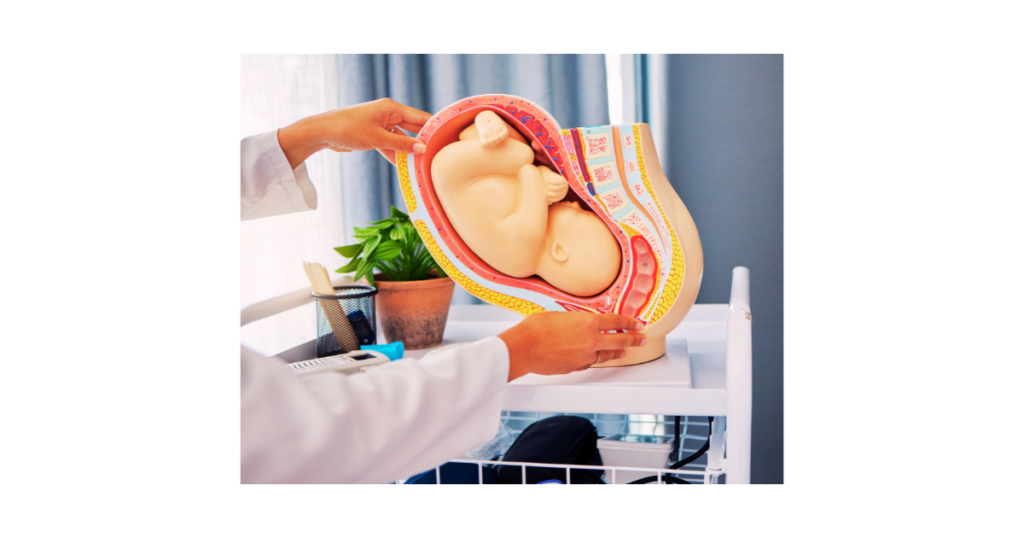A Journey Through the Three Phases
Pregnancy is an incredible journey that transforms your body, emotions, and entire world. It’s divided into three trimesters, each marked by unique milestones, challenges, and joys. Whether you’re navigating your first pregnancy or adding a new baby to your family, understanding what to expect during each trimester can help you feel more prepared and confident. Let’s break down each trimester step by step, and I’ll share some tips that might make these months even more special.
1. First Trimester: The Beginning

Overview
The first trimester begins the moment of conception and continues until week 12. For many, it feels like a whirlwind, full of excitement and the reality sinking in that you’re growing a new life. This stage sets the foundation for your baby’s development and your body’s adjustment to pregnancy.
Common Symptoms
Morning sickness, which can occur at any time of the day, is one of the most common and talked-about symptoms. While some lucky expectant mothers sail through with barely any nausea, others may feel the effects more intensely. I found ginger tea to be a lifesaver during my first pregnancy—it helped settle my stomach during the mornings.
You might also notice an increase in fatigue. Your body is working harder than ever, which is why rest and short naps become non-negotiable. I remember feeling surprised at just how tired I was—it felt like running a marathon every day, even if I hadn’t left the house.
Hormonal Impact
Pregnancy hormones like progesterone and estrogen are responsible for many of the changes you’ll experience. They prepare your body to support your growing baby by relaxing muscles and ligaments, which can lead to symptoms like bloating and tender breasts. The emotional roller coaster is real, too; some days you might feel on top of the world, while other days might feel more challenging.
Screening Tests
First-trimester screening tests are crucial for ensuring that your pregnancy is progressing as expected. These can include blood tests, ultrasounds, and, if necessary, genetic screening. Early screening not only helps you prepare but also gives you peace of mind.
Baby’s Development
By the end of the first trimester, your baby is about the size of a lime, but don’t let that small size fool you! Your baby’s major organs are already formed, fingers and toes have begun to develop, and a tiny heartbeat can often be seen on an ultrasound. This was always my favorite part—it’s the moment that makes everything feel so real.
Emotional Challenges
The first trimester can be a mix of excitement and anxiety, especially if it’s your first pregnancy. You’re getting used to all these new sensations, and it’s perfectly okay to feel a bit overwhelmed. Lean on your friends and family, and don’t hesitate to share your feelings. I found journaling about my experiences to be a comforting way to process the emotional highs and lows.
2. Second Trimester: The Growth Phase

Overview
The second trimester, spanning weeks 13 to 26, is often considered the “honeymoon phase” of pregnancy. Many women feel their best during this stage as morning sickness fades, and energy levels start to bounce back. This is when you really begin to enjoy being pregnant and may even start planning for your baby’s arrival.
Symptoms
Your baby bump starts to make its grand appearance, and with it, new symptoms. Stretch marks may appear as your skin stretches to accommodate your growing belly. Keep your skin moisturized—cocoa butter or coconut oil can be great natural options to help soothe the skin. Spider veins or varicose veins may also show up as your blood volume increases. Don’t worry; these are usually temporary and fade after delivery.
Another common symptom is increased appetite. As your baby grows, so does your need for additional calories. But try to focus on nutrient-dense foods rather than reaching for processed snacks. Frequent meals that include fruits, veggies, and lean proteins will help you maintain energy throughout the day.
Baby’s Growth
During this trimester, your baby grows from the size of an apple to about the size of a cauliflower. Their senses begin to develop, and they can start to hear your voice and other sounds. I used to talk and sing to my baby, knowing they could hear me made it feel even more real and special.
Prenatal Visits
These visits are vital for monitoring your baby’s growth, your blood pressure, and other vital signs. Around week 20, an ultrasound called the anatomy scan is typically done to check your baby’s organs and overall health. This is also when you may find out your baby’s gender if you choose to.
Health Tips
Nutrition plays a huge role during this stage. Incorporating foods rich in iron can help prevent anemia, which is common during pregnancy. Dark leafy greens, lentils, and lean meats are all excellent options. And don’t forget to stay hydrated—drinking plenty of water can help reduce the risk of swelling and varicose veins.
Movement Insights
One of the most delightful milestones of the second trimester is feeling your baby move. Those little flutters, known as “quickening,” can start as early as week 18. By week 22, you’ll likely feel more definite movements, like small kicks and shifts. These moments are perfect reminders of the tiny life growing inside you.
Screening
A glucose tolerance test is often performed during this trimester to check for gestational diabetes. Although the test can be a bit unpleasant (I’m looking at you, overly sweet drink!), it’s an important step to ensure you and your baby remain healthy.
3. Third Trimester: The Final Stretch

Overview
The third trimester is the home stretch, running from week 27 until birth. This period is marked by anticipation, excitement, and some physical challenges as your body prepares for labor and delivery. This is when you start counting down the weeks and days until you meet your little one.
Physical Changes
As your baby continues to grow, so does your baby bump. This often results in more pronounced weight gain, back pain, and pressure in your pelvic area. Leg cramps, frequent urination, and Braxton Hicks contractions are also common. I used to place a pillow between my knees while sleeping to help ease discomfort and support my hips.
Common Symptoms
Braxton Hicks contractions may become more noticeable. They can feel like mild menstrual cramps or a tightening of your abdomen. Unlike true labor contractions, they are usually irregular and subside with rest or hydration. Knowing the difference between these and true contractions is essential as your due date approaches.
Heartburn and acid reflux can make a comeback in this trimester. To help with this, avoid spicy foods, eat smaller, more frequent meals, and try not to lie down immediately after eating. I found that elevating my head with extra pillows at night helped reduce nighttime heartburn.
Baby’s Position and Growth

By now, your baby’s position is crucial. Most babies move into a head-down position by week 34, preparing for birth. Regular prenatal visits will include checking your baby’s position and monitoring your amniotic fluid levels. Feeling your baby’s kicks change from playful jabs to more defined movements as they run out of room is a bittersweet reminder that you’re nearing the end of this incredible journey.
Emotional and Physical Prep
The third trimester can be a mental marathon. Preparing your home for the baby, packing a hospital bag, and finalizing your birth plan are all activities that signal labor is near. I found it helpful to practice deep breathing and relaxation techniques during these last weeks to stay calm and centered.
Health Concerns
Blood pressure monitoring is more important than ever to rule out conditions like preeclampsia. Your doctor will also check for signs of gestational diabetes and any other potential issues. Be mindful of any signs such as severe swelling, persistent headaches, or vision changes.
Signs of Labor
As the final weeks approach, knowing what to expect when labor begins can ease a lot of anxiety. True labor contractions will become stronger, more regular, and won’t go away with rest. The loss of the mucus plug and leaking amniotic fluid are also signs that labor is near. Trust your instincts—if something feels off or you’re unsure, don’t hesitate to contact your health care provider.
Key Considerations for a Healthy Pregnancy
Prenatal Care
Consistent prenatal visits are essential, especially in the final trimester when your body is preparing for delivery. These visits help monitor your baby’s development, your blood pressure, and any other potential concerns. If you’re considered high-risk, more frequent checkups will be scheduled to ensure you and your baby stay healthy.
Staying Active and Healthy
Light exercise, like prenatal yoga or swimming, can help you stay fit and relieve some of the discomforts of pregnancy, like leg cramps and back pain. Staying hydrated and eating frequent, nutritious meals will also keep your energy levels up and manage stomach acid issues. Avoiding fried and overly spicy foods can minimize heartburn.
Preparing for Childbirth
Develop a birth plan that reflects your preferences for pain management, labor positions, and who you want in the room. Attending childbirth classes can provide both practical information and emotional support. Even after having more than one pregnancy, each experience taught me new tips and reinforced my confidence.
Recognizing High-Risk Indicators
Understanding when to seek help is important. If you experience unusual symptoms like leaking amniotic fluid, persistent leg swelling, or vaginal bleeding, reach out to your health care provider promptly.
A Delicious Gluten-Free Pregnancy Snack Recipe
| Gluten-Free Banana Oat Muffins |
| Perfect for when you need a snack that’s both filling and nutritious, these muffins are easy to make and adapt well to busy days. |
| Ingredients – 2 ripe bananas, mashed – 2 cups gluten-free rolled oats – 1/4 cup honey or maple syrup – 1/2 cup unsweetened almond milk – 1/4 cup coconut oil, melted – 1 tsp vanilla extract – 1 tsp baking powder – 1/2 tsp cinnamon – Pinch of salt – Optional: 1/4 cup dark chocolate chips or chopped walnuts |
| Instructions 1. Preheat your oven to 350°F (175°C). Grease a muffin tin or line with muffin liners. 2. In a bowl, combine the mashed bananas, honey, almond milk, melted coconut oil, and vanilla extract. 3. In another bowl, mix the rolled oats, baking powder, cinnamon, and salt. 4. Combine the wet and dry ingredients, stirring until well mixed. Fold in chocolate chips or walnuts if desired. 5. Spoon the batter evenly into the muffin tin. 6. Bake for 20-25 minutes or until a toothpick inserted into the center comes out clean. 7. Let cool for 10 minutes before enjoying. |
| Nutritional Value (per muffin) – Calories: ~150 – Carbs: 20g – Protein: 3g – Fat: 6g – Fiber: 3g |
| Potential Health Benefits – Fiber: Supports digestive health and helps reduce constipation, which is common during pregnancy. – Calcium and Vitamin D: Almond milk adds an extra boost for bone health. – Potassium: Bananas are rich in potassium, which can help manage leg cramps. – Complex Carbohydrates: Oats provide lasting energy. |
Final Thoughts
Pregnancy is a unique journey filled with excitement, anticipation, and moments of challenge. Whether you’re in the first trimester, eagerly awaiting that first baby bump, or in the home stretch counting down the days to giving birth, remember that each phase has its rhythm and significance. The most important thing is to listen to your body, trust your instincts, and enjoy the ride.
Take care of yourself, cherish these moments, and don’t hesitate to share your experiences with other expecting moms—it’s a journey that’s better shared.
Are you in the middle of your pregnancy journey or preparing for your next baby? Share your stories in the comments below or subscribe to our newsletter for more pregnancy tips, healthy recipes, and lifestyle advice. Let’s navigate this beautiful journey together!
| FAQ |
| 1. What are common first trimester symptoms? Expect morning sickness, fatigue, and hormonal changes. Emotional ups and downs are also common. 2. How do you manage third-trimester discomforts? Stay hydrated, practice gentle exercises, and avoid spicy or fried foods to manage heartburn and leg cramps. 3. When can I expect to feel my baby’s movements? Usually, between weeks 18-22 in the second trimester. 4. What is the importance of prenatal visits? They monitor your baby’s growth, check for potential issues, and track your health. 5. What’s a healthy snack for pregnancy? Try gluten-free banana oat muffins for a fiber-rich, nutrient-packed treat! |
Additional Resources
For more information on pregnancy and healthy living, explore these trusted resources:
- Mayo Clinic: Pregnancy Symptoms by Trimester
- American Pregnancy Association: Fetal Development by Trimester
- What to Expect: Managing Common Pregnancy Symptoms
- Healthy Pregnancy Recipes from EatingWell
- Lamaze International: Preparing for Childbirth
- CDC: Prenatal Care and Maternal Health
Outbound Links Summary:
Dive deeper into pregnancy care and wellness with guides from the Mayo Clinic, American Pregnancy Association, and What to Expect. Find nutritious meal ideas from EatingWell and childbirth preparation tips at Lamaze International. Additionally, explore maternal health recommendations from the CDC.





